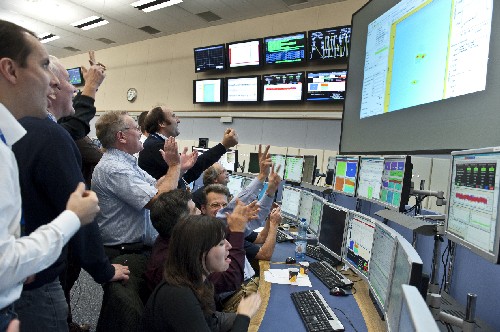
CERN has confirmed the first simultaneous acceleration of two separate proton beams around the Large Hadron Collider (LHC).
Occurring just after noon today (Central European Time), the result marks another important step in the restart of the collider, which was forced to shut down 14 months ago following a catastrophic liquid helium leak.
We are at the end of 20 years of effort from the international scientific community,” says Fabiola Gianotti, the Italian particle physicist in charge of ATLAS, one of the two main detectors at the LHC. “This is the beginning of a fantastic new era of physics, which we hope will change the physics textbooks.”
Swift progress
The news follows the announcement on Friday that CERN had successfully circulated individual proton beams around separate rings of the LHC’s 27 km tunnel.
Further progress followed on Saturday when CERN engineers were able to “capture” the beams using a radio frequency (RF) system, meaning that protons are circulating in coherent bunches rather than spreading out around the ring.
In today’s breakthrough, both beams were powered up at the same time with one being circulated clockwise and the other anticlockwise.
“Thanks to the tireless work of our engineers, we are progressing faster than we could have hoped for on Saturday,” says Archana Sharma, a scientist on the Compact Muon Solenoid (CMS) experiment, the other major detector at the LHC.
Sharma told physicsworld.com that the mood at the particle physics laboratory is one of great optimism but people are saving the real celebrations until the first collision of the beams.
Like a new car
The first low energy collisions at 1.2 TeV per beam are expected within the next two weeks with the beam energy being gradually raised to 3.5 TeV per beam by the beginning of next year.
Rolf-Dieter Heuer, the director general at CERN regards it is a “great achievement” to have made such quick progress, but he is quick to state that the facility will maintain a cautious approach to the LHC’s restart. “I use the analogy of a new car – you would never dream of accelerating a new vehicle to its maximum power upon its first use,” says .
The CERN boss was speaking as part of a live web-broadcast today in which he entertained viewers by acting out the LHC’s antiparallel beamlines through a series of hand gestures.
“We need to get confidence in the machine before we can start to open new windows in physics,” he says.



